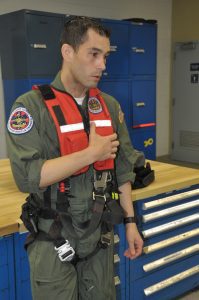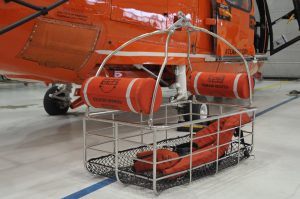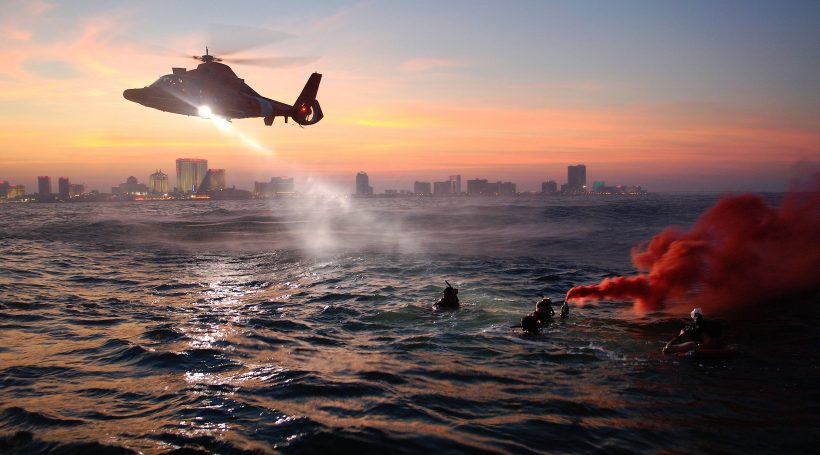On a frigid December night, a small fishing vessel off the coast of Barnegat Light capsized after being battered by huge waves. Tragically, two of the three crew members went down with the boat. The lone survivor, wearing a T-shirt and shorts, escaped the wreckage and climbed into a raft, which had inflated when the boat became deluged with water.
Miles away, crews at Coast Guard Air Station Atlantic City received the vessel’s distress signal. Minutes later, the crew aboard the rescue helicopter spotted the debris in the stormy waters more than 30 miles off shore. With the wreckage in his sight, rescue swimmer Pepe Carire jumped from the hovering aircraft and plunged into the freezing water.
Carire fought his way through six-foot waves until he reached the overturned life raft violently bobbing in the rough water. He knew there was a survivor inside, but the zipper was jammed. After struggling for several minutes, he used his hands to rip the raft open.
He then pulled the shipwreck’s 280-pound survivor, who was already suffering from hypothermia, out of the raft and signaled the helicopter to lower the rescue basket. Despite the fact that he was also beginning to experience hypothermia, Carire tread water until the crew safely raised the fisherman into the aircraft and again lowered the basket for him. Once inside the helicopter, Carire used his medical training to treat the survivor and keep him conscious until they reached the hospital.

Aviation survival technician Pepe Carire demonstrates the harness rescue swimmers wear
For Carire, it was just another day on the job as a Coast Guard aviation survival technician (AST), or rescue swimmer as the brave men and women are often called. They’re an elite division of the Coast Guard trained on rescue techniques, helicopter deployment methods, emergency medical care and other technical skills like small engine repair and parachute packing. Their motto – So Others May Live – epitomizes their mission.
Though they’re often called rescue swimmers, these military members perform more than just water rescues, sometimes saving people stranded atop cliffs, power lines and even oil rigs. In the first five days following Hurricane Katrina, AST crews performed almost 34,000 rescue and hoist operations of victims stranded on rooftops and in flood water – reportedly more than the Coast Guard had rescued worldwide in more than 50 years.
Brutal Training
The 18-week training course required to become an AST is one of the most physically and mentally challenging programs in the U.S. military. (It was prominently featured in the 2006 film “The Guardian” starring Kevin Costner and Ashton Kutcher.) “To say it’s intense would be an understatement,” says Carire. “You’re pushed and beat down for eight, nine, ten hours a day. The instructors want to see how much you can take before you break.”
This could mean treading water for an hour while holding a 10-pound weight, or it could mean swimming underwater for 50 yards without coming up for air. Other days, recruits might be forced to swim across an icy river and then run five miles in their freezing clothes.
The training is all designed to make the rescue swimmers comfortable in the water, but it’s about much more than just swimming or being physically tough. “Lots of collegiate swimmers and polo players who are great swimmers fail out of the program. You have to learn to think and carry out a rescue while submerged, holding your breath and getting tossed around by huge waves,” says Caleb Flippen, another AST stationed at Coast Guard
Air Station Atlantic City. “You learn very quickly during training that if you panic, you will die while on the job.”
Carire agrees, saying, “The physical aspect is exhausting, but the mental challenge is the hardest. You’re tired, your body hurts and you’re sore all over, but you have to find the strength to wake up every morning and do everything over again. Not everyone is cut out for this job.”
To say that would be an understatement: the Coast Guard AST program has one of the highest student attrition rates of any special operations schools in the military. Roughly 75 students enter the training each year, but less than half make it out. “There are only about 300 Coast Guard rescue swimmers in the entire United States,” notes Flippen. “They’re spread out over 26 or 27 stations.”
Conducting Rescues

The basket is the main rescue device used by aviation survival technicians
At Coast Guard Air Station Atlantic City, Carire and Flippen are stationed with 16 other rescue swimmers along with a number of pilots and flight mechanics. The crews are responsible for conducting rescue missions within 150 nautical miles, which encompass the coastlines of Connecticut, New York, New Jersey, Pennsylvania, Delaware, Maryland and Virginia, as well as interior bays and rivers such as the Chesapeake, Delaware, Hudson and Long Island Sound.
“Two swimmers are on duty every day,” says Carire. “We do a lot of flight training, so in the 24 hours you’re on duty, you have about six hours of flight time. The flight time is really stressful on the body because of all the vibrations from the helicopter, so those six hours actually feel a lot longer.”
When the swimmers aren’t on training flights or conducting rescues, they’re expected to maintain equipment, stay up-to-date with their EMT training, keep physically fit and be ready to spring into action as soon as the emergency beacons ring out. “When I hear the beacon, it’s like music to my ears,” says Flippen. “I automatically go into battle mode. I guess you could say I’m an adrenaline junkie. I actually get a little jealous when I hear about rescues happening on the days I’m not on duty.”
The crew is required to be dressed and loaded within 30 minutes of the beacon sounding. For the swimmer assigned to the rescue, that means donning more than 10 pounds of equipment. This includes a strobe, flares, a knife, a waterproof radio and the harness that helps raise them back to safety.
Once in the air, the AST is responsible for directing the mission, explains Carire. “The pilots look to the swimmer for direction. We always try to keep it simple, and you learn to follow your instincts. As soon as you jump out of the helicopter, you’re completely alone, so you have to make good decisions or you won’t make it back.”
Still, there’s always the chance things can go tragically wrong. “You might be in the water with four or five people who desperately want to get out of the water, and sometimes there is the occasional person who freaks out,” says Flippen. “If they’re panicking, they might cling to you or fight off your attempts to help them, which obviously puts the swimmer in danger.
“In those cases, the swimmer might dive underwater to get the person off them. Or, the swimmer might even be forced to dunk the person underwater to shock them and then explain that they have to relax before we can help them. You can’t let them control the situation – the swimmer always has to maintain control.”
And despite the swimmers’ heroic attempts, not all can be rescued. “Your first loss – when you realize you can’t save everyone – it sticks with you forever,” says Flippen. For him, it involved two men desperately clinging to the side of a capsized sailboat. “I put one of them in the basket and signaled for the helicopter to raise him up. By the time I got to his friend, he was gone. You’re disappointed in yourself, and you blame yourself.”
Carire adds that the ASTs can’t give themselves the option of dwelling on the negative or feeling fearful. “What’s important is that we keep expanding on our abilities and save everyone we can.”













